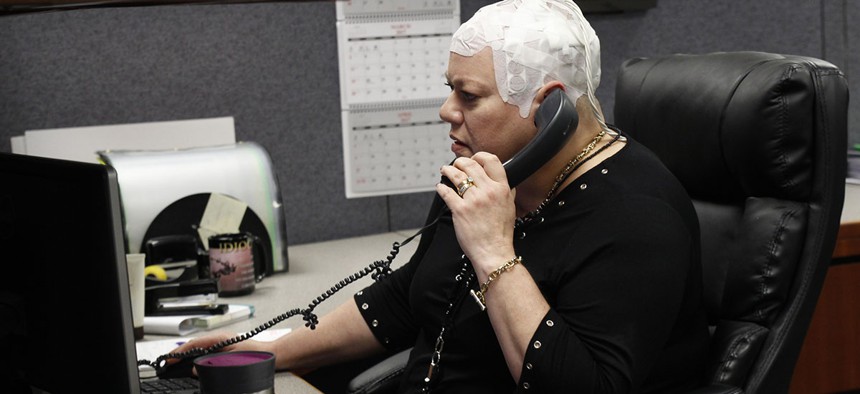Scientists Made a Cancer-Fighting Cap That Stops Tumors From Growing With Electricity

Joyce Endresen wears an Optune therapy device for brain cancer, as she speaks on a phone at work in Aurora, Ill. Carrie Antlfinger/AP
After five years, 13 percent of patients who used the cap were alive compared to 5 percent who did not.
Scientists made it possible for terminally ill cancer patients to wear part of their treatment while they go about their days.
On April 2 at the annual meeting of American Association for Cancer Research (AACR) in Washington, D.C., researchers announced that the Optune therapy caps—which look like swim caps lined with electrodes attached to a small generator—worked to keep patients with a rare form of terminal brain cancer, called glioblastoma multiforme, alive for longer than existing treatments. When used with chemotherapy, the median survival rate increased from 16 months to 21 months after diagnosis. After five years, 13 percent of patients who used the cap were alive compared to 5 percent who did not.
The survival rate may seem small, but for such a fast-growing cancer, extending life with minimal side effects means the world. Joyce Endresen, a 52-year-old brain cancer patient who used the cap as part of her treatment, told the AP that after having two years of clean scans, she’s celebrated by taking a trip to South Africa.
The caps work by creating a small electrical field that interferes with the way cells divide. Quickly dividing cancer cells find themselves unable to multiply, while slow-growing neurons remain unaffected. Patients have to keep their heads shaved to wear the cap for 18 hours a day. When the cap is on, patients feel a little bit of heat on their heads. Some reported feeling weak and scalp irritation, but these side effects were relatively minor.
The U.S. Food and Drug Administration has approved these caps for use in clinical trials while doctors continue testing their effect, but they’re far from standard treatment. The results presented at the AACR were from a study sponsored by Novocure, the British company that makes the device. Both doctors and patients knew whom was receiving the caps in addition to chemotherapy; usually, control groups are given a sham treatment and kept hidden to eliminate any kind of placebo effect. And they’re not cheap: a year’s treatment costs $252,000. According to Novocure, these costs account for 17 years of research and development, plus the production of a unique technology in small numbers. Insurance can help patients cover most of the cost and Novocure will give them to patients on Medicaid for free.
Still, researchers are hopeful that these kinds of electric fields will help keep aggressive brain tumors at bay for longer. In addition to more tests on the Optune cap, scientists hope to test other wearable patches that emit similar electrical fields on different types of cancer, including pancreatic, lung, and ovarian cancer.
NEXT STORY: Why Trump should dump spreadsheets


